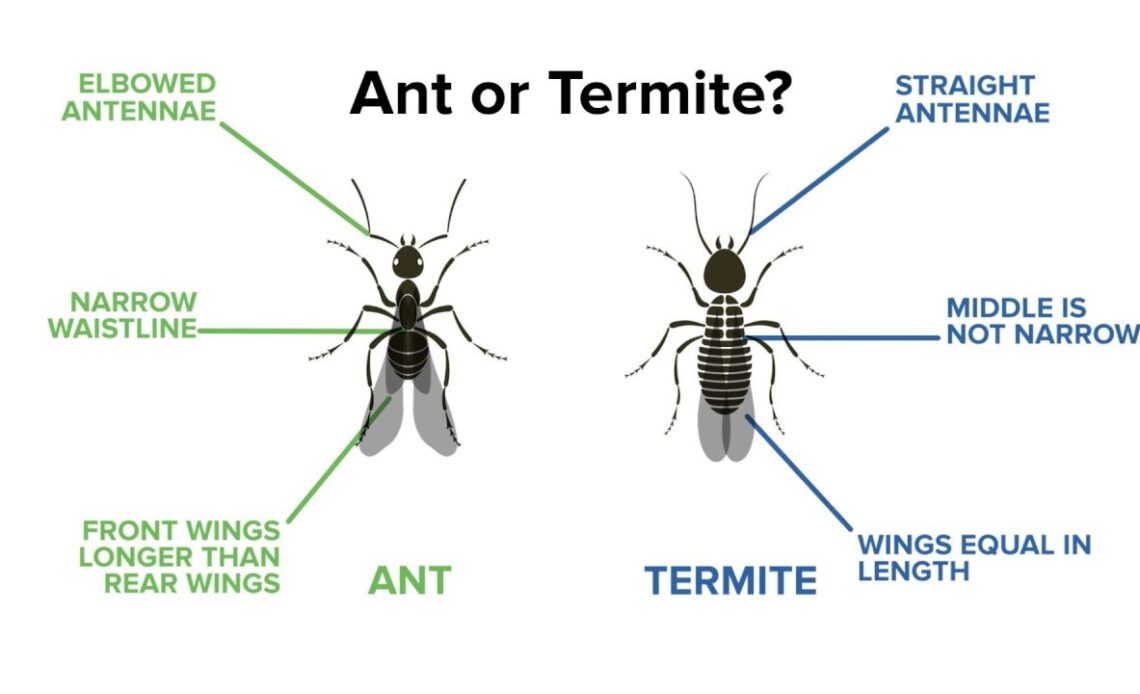Usually, you find yourself panicking when you see a swarm of microscopic insects walking around your house. Are they termites or ants? Worse still? Although both pests are tiny, gregarious insects that can swarm your house in great numbers, their presence has somewhat distinct consequences. Most of the time, termites are annoying and can be controlled with simple pest management. To act appropriately, you must be able to distinguish termites from ants. Let’s examine the main variations between these two insects, including their appearance, behaviour, and harm they inflict, so you can appropriately identify them and handle the matter.
Appearance: Spotting the Visual Differences
Particularly when they are swarming, termites and ants can first seem to be somewhat similar. They differ physically, though, and knowing what to look for will help you determine which bug you are dealing with.
- Body shape – Termites and ants differ most obviously in their bodily forms. From head to tail, termites look more homogeneous because of their straight, cylindrical body with no obvious waist. By contrast, ants have a clear pinched waist, which results in a segmented body with a limited “waistline” separating the thorax from the abdomen.
- Antennae – The form of their antennae is another unique quality. Termites have beaded, straight antennae like small pearls’ strings.
- Wings – Though their sizes and shapes vary, both ants and termites have two pairs of wings. With their characteristic veined, transparent look, termite wings are equal in length and far longer than their bodies. The front wings of ants are significantly larger than the rear ones. Also, their wings tend to point more towards the tip of their bodies.
Identification of termites from ants depends on an awareness of these visual variations. If you’re not sure, gathering a specimen and closely reviewing it—or better still, speaking with a pest management specialist—can provide clarity and guide you in acting.
Behaviour: How Termites and Ants Act Differently
Termites and ants have different behaviours that will help you distinguish them. Knowing the behaviour of every insect can help you determine which pest has entered your home.
Feeding Habits
Because of their ravenous taste for wood and other cellulose products, termites are sometimes referred to as silent destroyers. They eat the structural wood in your house, which causes damage, usually invisible, until it becomes really severe. Termites feed from complex tunnels they make inside wood, gradually hollowing it out, therefore compromising the integrity of your property.
Usually invading kitchens and pantries in quest of crumbs, spills, and open food, most ants are drawn to sweet meals, proteins, and grease. Though they tunnel into the wood, Carpenter ants – a particular kind of ant sometimes mistaken for termites – do this to build nests rather than for food. Though still cause for worry, this makes them less damaging than termites.
Nesting Preferences
There may be millions of termites in a colony. You can find nests in the ground, in wood, or house construction. The most often occurring termites are subterranean ones, which build mud tunnels connecting their colony to the food source, therefore preserving the moisture required for survival.
Although they live in colonies as well, ants have somewhat different nesting behaviour. They might construct nests in walls, behind rocks, in the ground, or even inside the insulation of your house. Unlike termites, ants’ nests can be found in a greater spectrum of habitats since they do not depend on moisture as much.
Swarming Behaviour
Swarmers are winged, reproductive individuals. Their purpose is to reproduce and start new colonies. Usually visible in the spring, termite swarmers are drawn to light and can be seen next to windows, doors, or light bulbs. Termites drop their wings after mating, usually found in piles, which is a clear indication of their existence.
Depending on the species, ant swarmers are spotted at different times of year and are drawn to light as well. Still, their swarming is often less dramatic and more erratic than that of termites. Seeing when and where swarming activity occurs might provide you with important hints on the type of termites or ants you are dealing with.
Damage: The Different Impact of Termites vs. Ants
Termites and ants harm properties in different ways; hence, knowing their degree of influence will help you find the offender. Termite damage frequently impacts the structural integrity of your house. Hence, it is more severe, and damage normally only causes contamination and nuisance.
Termite Damage
Termites eat wood from the inside out. They create tunnels and galleries inside walls, floors, and other wooden structures.
Often concealed behind flooring or walls, this damage is difficult to find until it becomes noteworthy. Among the indicators of termite damage include hollow-sounding timber, sagging ceilings or floors, and the look of mud tubes on foundations or walls.
Termite damage can be costly financially and usually calls for major repairs. Severe termite infestations can endanger the safety of your house and result in expensive structural replacements or reinforcements.
Ant Damage
Although ants do not eat wood, carpenter ants can destroy wooden buildings by hollowing them out for their nests. Usually less severe than termite damage, this deterioration can, over time, weaken door frames, timber beams, and other buildings. Especially in kitchens, where they hunt for food, ants are especially infamous for polluting surfaces and food.
The main worries of most ants are their tenacity and capacity to enter food storage spaces, which can be annoying and dirty. Unlike termites, their damage is usually limited to particular regions and does not widely compromise the foundation of your house.
Prevention and Control: How to Manage Termites and Ants
Identification is the key to effective pest control, followed by targeted prevention and treatment. Taking proactive steps can help you protect your home from these pests.
Termite Prevention and Control
Since termites flourish in wet environments, concentrate on lowering moisture around your house to help prevent them. Fix leaks, guarantee correct drainage around your foundation, and maintain gutters free to stop water buildup. Eliminate any mulch, firewood, or wood trash from near the edge of your house since these products draw termites.
Should you suspect a termite invasion, expert action is absolutely vital. Experts in pest management can closely examine and determine the type of termite and apply focused treatments, including liquid termiticides, soil treatments, and bait stations. Minimising damage and preserving your property depend on early identification and quick response.
Ant Prevention and Control
Keeping your house clean and closing any access points is part of ant protection. Keep food in sealed containers and sweep and wash floors frequently to remove crumbs and residue that attract ants. Look for cracks, gaps, and other openings on the outside of your house – seal them to stop ants from getting in.
Usually used to manage the population in ant infestations are bait stations and insecticidal sprays. Knowing the particular ant species can assist you in deciding on the best course of action. Professional pest control services can offer more complete answers in cases of ongoing or major infestations.
When to Call a Professional
While do-it-yourself techniques can be successful for minor infestations, major termite or ant issues usually call for the knowledge of a professional. In particular, termites can cause significant damage that is hard to find. Hence, professional inspections and treatments are the best lines of action. Using their instruments, knowledge, and experience, pest control professionals can evaluate the degree of an infestation, apply focused treatments, and offer continuous monitoring to stop more issues.
You should bring in the experts if you’re not sure whether you are dealing with ants or termites or if your attempts at infestation control have failed. Early intervention can save you time and money and the worry of coping with these tenacious bugs.
Conclusion
Although, at first sight, termites and ants are identical, knowing their main differences will enable you to act appropriately to guard your house. Identification and control of these pests depend on knowing what to search for, from their different physical traits to their particular habits and the kinds of harm they inflict. Termites and ants won’t be able to turn your house into their next target if you remain alert, use good preventative measures, and get professional aid as needed. Don’t wait until the harm is done; empower yourself with knowledge and start today to keep your house free from pests.

